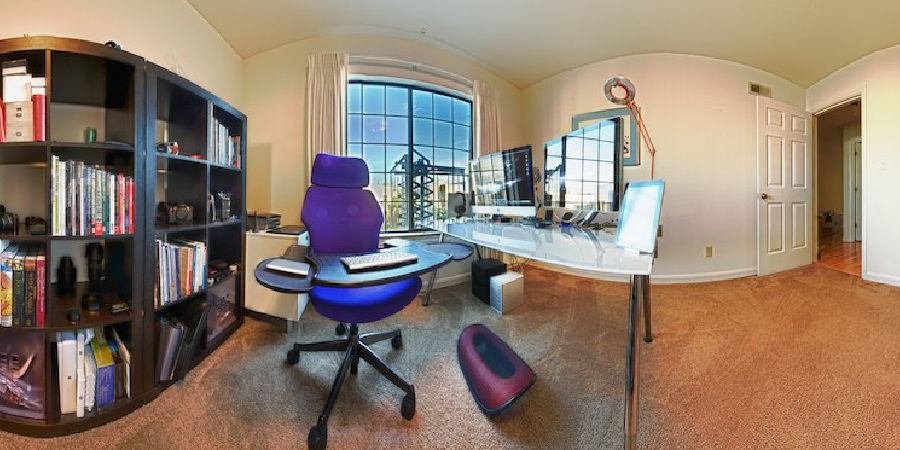A chair is a common piece of furniture found in most homes. Chairs are usually easy to assemble, but there may be times when the chair is not level. This can cause problems when sitting in the chair or using the chair for other purposes.

You can do a few things to make sure your chair is level when assembling it. This will help ensure that it is stable and safe to use. This blog post will show you how to level a chair when assembling it. We will also provide tips on preventing this from happening in the future. Let’s get started!
10 Methods on How to Level a Chair When Assembling:
1. Adjust the Feet
This is one of the easiest ways to level a chair. Adjusting the feet may require you to dig in with your fingers to rotate them. The feet are threaded, so they can turn to screw themselves deeper into the floor or loosen themselves. Turn them in the appropriate direction until the chair feels solid underneath you.
2. Distribute Weight
If necessary, redistribute your body weight by shifting your position on the seat. If you are sitting too far towards one end of the chair, one leg will likely be bearing more of your Weight than the other. Move to an area of the chair where you feel balanced and sit comfortably.
3. Use a Level
When assembling a chair, you may find it helpful to use a level as a reference point. A level can help you determine whether or not parts are perpendicular to each other. It is an easy fix if the chair parts lean ever so slightly in one direction. Loosen or tighten a few screws and try again with the level to make sure your chair sits even and balanced.
4. Make Small Adjustments
If you can’t get all of the legs on a chair to touch the floor, consider making small adjustments to the height of individual legs. The short leg is likely due to uneven flooring, in which case you may need to make small changes for your chair to sit level.
5. Stack Books or Place a Board Under Hinges
If your chair’s feet are adjustable, consider stacking several books underneath them to raise them. This can be helpful if you need to bring the chair’s feet closer to the floor without making the chair unstable. You also have the option of placing a board underneath adjustable hinges to make them sit at a better height.
6. Place Something Heavy and Upright
If your chair sits high off the floor, consider placing something heavy and upright underneath the front legs. For example, you could place a few books or bricks under each chair’s front legs to make it more stable.
7. Use Casters
Casters are small wheels that attach to the bottom of furniture to keep it mobile while still sitting level on the floor. Some chairs come with casters already attached, but if not, they can be purchased and installed at a hardware store.
8. Add a Rubber Pad or Mat Under the Chair
If you have a chair that cannot be adjusted, consider an alternative solution to ensure it sits level on your floor. You can purchase rubber pads from a hardware store and glue them to the bottom of your chairs to make them sit evenly on floors with different height levels. Another easy fix is to cover the floor underneath your chair with a rubber or plastic mat to level it out.
9. Use a Ladder
Leaning a ladder against a wall and placing a solid step stool on top of it can help you get high enough off the ground to make adjustments necessary for leveling a chair. If you need more height than a ladder can offer, you could also use the steps of an extra staircase.
10. Adjust the Leveling Glides
Some furniture has leveling glides underneath the legs to level it with the floor. You can usually adjust these glide screws on your own by turning them with a screwdriver or drill bit. If you have trouble reaching underneath the chair, someone else may need to help to level your chair for you.

Some Helpful Tips and Suggestions:
Here are some tips and suggestions on how to level a chair when assembling.
1. Make sure chairs are completely level throughout the entire process. If they are not, this will likely result in a wobbly chair.
2. Be sure to attach the legs equally on both sides of each chair, using either wood screws or dowels.
3. Make sure that you are screwing the bolts into the center of each dowel, creating each leg. If you are screwing the bolts into either end of the dowel, that could result in an uneven chair.
4. If at any point one of your chairs feels unstable or unsafe, you should start over with fresh pieces.
5. First, attach the front legs to the front of the chair frames, then attach the back legs to the backs of each chair frame. Do not put all the legs on the chair before attaching the other pieces.
6. Make sure to attach at least two screws or dowels to each piece, making them sufficiently stable so that they won’t fall apart while you are assembling. Try not to overtighten bolts into dowels by using too much pressure, as it may cause wooden pieces to split or crack.
7. Make sure that the legs are straight to prevent wobbly chairs.
8. Before assembling your chairs, make sure that you are using either wood screws or dowels to attach the legs and other parts of the chair. Using nails may cause your furniture to fall apart while you assemble it.
How Do You Fix an Uneven Chair?
A common problem when assembling wooden rocking chairs is that they may be uneven. A slight difference can be acceptable, but if it’s not level with the floor or other chairs, you’ll need to rectify the issue, so they are usable and comfortable. It’s not an easy task, but you can level a chair with some patience.
Before you start leveling a chair, you should do a few things to ensure the task goes smoothly. First, make sure that all of the legs are lined up evenly, and none have been damaged or broken during shipping or use. It’s best to go through this process with all the screws securely in place before they’re all removed.
Five Alternative Methods for Fixing an Uneven Chair:
1. Sand Each Leg Evenly
This is the easiest way to level a chair, but it’s also time-consuming. In addition, it can be messy if you are not careful because of all the sawdust that builds up during the sanding process. The only tools you need are a hand sander or a square file and a square.
2. Fabricate a Shim from Wood
If you don’t have any wood laying around, use what you do have: cardboard. This technique is best used when leveling chairs because the fabric is easily manipulated into different thicknesses.
To get the measurements right, place your fabric shim on top of the chair leg and mark how much space is left between the top of the fabric and the bottom of the leg. Next, make a second mark the same distance up from the bottom of the leg. Finally, take a pair of sharp scissors and cut at both marks. You now have a shim that can be placed between your chair’s leg and the floor.
3. Fabricate a Shim from Metal
This is the same process as fabric, but you can use aluminum flashing. It offers more support than fabric and it remains stable in temperate climates fabric tends to bow in heat and cold. Like the fabric shim, this one also has two measurements: how much metal needs to be cut away from the top and how much needs to be cut away from the bottom.
4. Buy a Wedge Kit
This is the quickest way to level your chair, but it’s also the most expensive. The kit can be bought at home centers or hardware stores and contains wedges that are inserted into the leg of your chair after you’ve placed the adjustable glides. As the screw of the glide is tightened, it squeezes the wedges together and brings your chair leg to an even level with all of your other chairs.
5. Use a Metal File
If you don’t have any wedges, metal files can be used, too. You’ll need to use this technique if you want your chairs to remain level all the time and not just when you’re assembling them.
To remove some of the material from your chair leg, place it on a table and rub the file against the side of the leg toward the bottom. You can also place your file against the table and rub your chair leg against it to remove some material from the top portion of your leg.
Conclusion:
The steps to level the chair are as follows. First, stand on one side of the row with your feet pointing inwards, and then place a foot at each end of the row. This will be where you put your Weight while pushing against it until all four legs are evened out.
If this is not sufficient for leveling purposes, use something heavy like a cinderblock or large book to ensure that both sides are balanced before continuing onto the next step. We hope this blog post on how to level a chair when assembling has been helpful. If you have any questions or want to know more, then feel free to comment below!
You may read also – How to Cover an Office Chair Without Sewing

